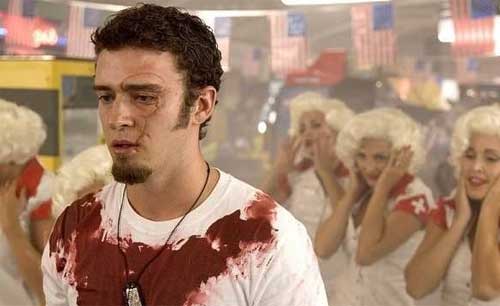Director: Hayao
Miyazaki
Released: 1997
Starring: Billy
Crudup, Billy Bob Thornton, Minnie Driver, John DiMaggio, Claire
Danes, John DeMita, Jada Pinkett Smith, Gillian Anderson, Keith David
Plot: After being
cursed defending his villiage from a rampaging boar-god turned demon,
Ashitaka (Crudup). Now he must venture to the western lands to true
and find a cure, only to soon find himself caught in the battle
between the residents of Irontown lead by Lady Eboshi and the forest
gods.
Review: When we look
at key Anime titles its often far too easy to go straight to the
likes of “Akira” and “Ghost In The Shell” and overlook the
titles of Studio Ghibli which unquestionably played a key part in bringing Anime to
western audiences with this film in particular being of the key
titles in their extensive back catalogue while this film would also be the highest
grossing film of all time in its native Japan until the release of
Titanic which came out the same year.
Returning from his
four year break from directing after “Porco Rosso” here legendary
director Hayao Miyazaki brings a much darker vision to this film
than had been previously produced by “Studio Ghibli” aswell as a
more revolutionary animation style for the time as elements of the
film used computer animation to blend and support the traditional
cel animation with a prime example being the writhing worm like demon
flesh which appears throughout when one of the gods is corrupted. At
the same time Miyazaki ever the perfectionist personally corrected /
redrew more than 80,000 of the 144,000 animation cels which make up
the film.
A sweeping and epic
production, the film really hits the ground running with the opening
attack on Ashitaka’s village this is another film which really
shows the potential for animation as Miyazaki once more refuses to
believe that the medium should be limited to childish fare as here he
crafts a very grown up fantasy tale as limbs are torn off and
battlefields are shown covered in mass casualties. This of course is
nothing new for Studio Ghibli as the previous films have featured
some surprising moments of violence such as a villain being crushed
between then hands of a clock and a small army being dropped out of
the bottom of a flying airship its just before they’ve been covered
more by the general charm of the film, though I don’t think Disney
where expecting what they got here when they agreed to distribute the
film which also under their agreement couldn’t even edit the film
to fit in more with their catalogue, though they did release it into
fewer theatres than originally planned seemingly in response to their
editing request being refused.
The environment, a long time favourite theme of Miyazaki and here he once more get to
make it the central theme as the meat of the story is based around
the ongoing battle been man and nature in this case the residents of
Irontown whose expanding town and need for resources puts them in
constant conflict with the forest gods in particular the wolf goddess
Moro (Anderson) and her adopted human child San the self-dubbed
Princess Mononoke. The ongoing rivalry between San and Lady Eboshi is
one of the highlights of the film with Eboshi having command of
explosives and advanced weaponry, while San rides into battle on her
giant wolves while demonstrating lightening sharp reflexes which
makes their confrontations such a thrill to watch. It's intresting though that Miyazaki never brands either of those characters as being the villian, even though it can be assumed that San is the heroine of the pair, while Eboshi on the other hand is hardly the villian as she does only what she think is best for Irontown than actively seeking to destroy the surround forests.
Also thrown into the
mix is the wandering monk Jiko-bo (Thornton) who despite his friendly
nature might be the most devious character of them all, as he plans
to use Ashitaka to locate the Great Forest Spirit whose head he plans
to capture for the Emperor believing it grants the powers of
immortality.
For Miyazaki the
forests which surround Irontown are home to giant animal gods and
playful spirits presided over by the forest spirit which has the
power over life and death, Miyazaki here managing to combine his
sense of fantastical wonder and delight with much darker moments than
we have come to expect from his work and yet somehow it all
complements each other so that we can have scenes of Joko-bo’s men
infiltrating the forest wearing the skins of the slain boar army
along the adorable head rattling kodama.
As to be expected
from a Studio Ghibli film the animation is sumptuous throughout while
complemented by the orchestral soundtrack composed by Joe Hisaishi.
At the same time the dub track while not perfect does feature a
fantastic cast who all embrace their roles while including a subtle
turn for Gillian Anderson as the giant wolf god Moro.
While perhaps not
having the same surface charms of the other Studio Ghibli films this
one has real depth especially with its characters and storytelling
which never feels the need to dumb things down for its audience,
while also knowing just how dark to go before pulling back. Here
Miyazaki is clearly working at the heights of his powers crafting
something truly special which truly lives up to its reputation of
being an essential anime classic.

























